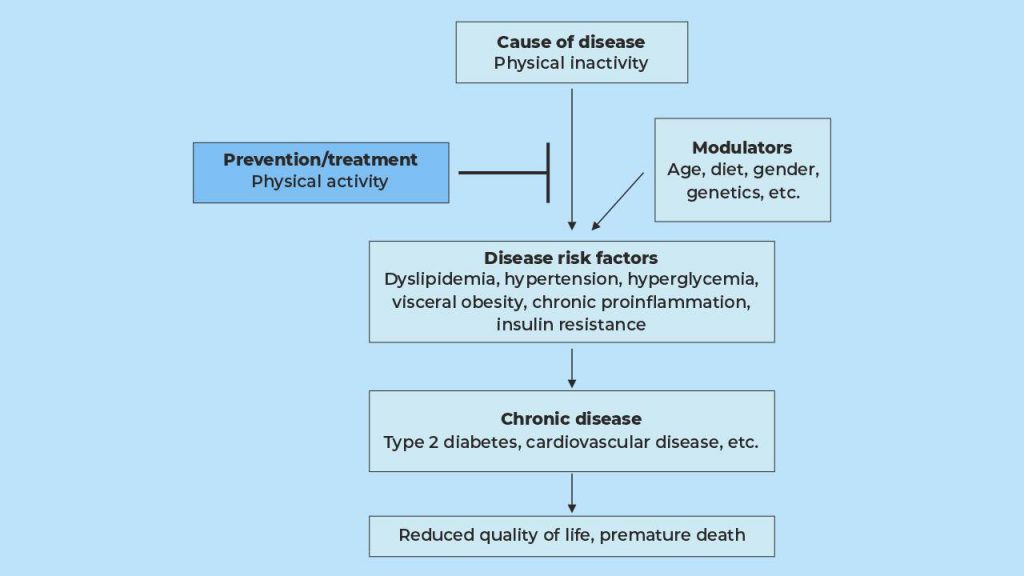
How Does Exercise Benefit Your Body?

Greek physicians of the fifth and early fourth century BC were the first to establish that exercising and eating nutritious food leads to sound health. The relationship between physical activity and fitness has since been established beyond a doubt. Working out regularly has numerous health benefits such as the reduced risk of cardiovascular diseases, type-2 diabetes, hypertension, obesity, and cancer. It also has manifold positive effects on mental health.
Unfortunately, around 28% of adults and 81% of adolescents worldwide do not meet the recommended levels of physical activity. Just three modern behaviors — smoking, poor eating habits, and lack of physical activity are found to be major contributors to chronic health problems in developed countries.

Benefits of physical exercise
Cardiovascular disease (CVD)
CVD is a group of complications of the heart and blood vessels:
- Hypertension – High blood pressure
- Coronary heart disease – Includes angina and myocardial infarction (heart attack)
- Cerebrovascular disease (stroke) – Caused due to the formation of a blood clot, or a bleed into the brain
- Peripheral vascular disease – Narrowing of peripheral arteries leading to compromised blood flow
- Heart failure – Caused when the heart is unable to pump optimal blood to meet the demands of the body
- Rheumatic heart disease – Causes damage to the valves of the heart, impairing its capacity to control the direction of blood flow
- Cardiomyopathies – Complications caused by structural abnormalities of the myocardium
Role of exercise: There is ample epidemiological evidence of regular physical exercise and an active lifestyle reducing the risk of developing cardiovascular diseases. Here’s how:
- It improves lipid and lipoprotein metabolism – Research suggests that regular aerobic exercise can help in increasing the levels of high-density lipoprotein cholesterol (HDL-C) and lowering the triglycerides levels in the blood.
- Hypertension – Exercise has a positive effect on blood pressure
- Exercise prevents coronary heart disease by improving oxygen delivery throughout the body
- It improves endothelial function (the ability of the thin layer of cells lining blood vessels to interact with smooth muscle to influence blood flow)
- Exercise reduces the risk of thrombosis (blood clots) and inflammation
Diabetes
It is characterized by chronic high blood glucose concentration and non-esterified fatty acid (NEFA) concentrations. Diabetes plays a significant role in developing CVD, which is a leading cause of death globally. Diabetes can be type 1 or type 2. Type 1 diabetes is also known as insulin-dependent diabetes mellitus. Autoimmune destruction of the pancreatic cells is the cause of type 1 diabetes. Type 2 diabetes results in insensitivity to the effects of insulin, referred to as insulin resistance. It impairs the ability of insulin to clear glucose from the blood into the cells.
Role of exercise: Exercise helps by
- Having a positive effect on glucose tolerance
- Improving insulin sensitivity
- Improving glucose uptake in muscle cells. Majority of glucose is disposed of in the skeletal muscle, and physical exercise improves this uptake of glucose
- Improving blood flow
Obesity
It is defined by excess accumulation of body fat to the point of one’s health being at risk. Often, body mass index is used to assess obesity.

WHO Asian BMI classification
- Underweight: Under 18.5
- Normal weight: 18.5-22.9
- Overweight: 23-27.5
- Obese: 27.6 and above
Obesity results from a long term imbalance between energy intake and energy expenditure. The excess energy intake results in weight gain and storage of energy in the form of fat. Obesity is associated with numerous health complications such as type-2 diabetes, CVDs, hypertension, arthritis, and cancer. Low levels of physical activity and excessive energy food intake is the major cause of obesity.
Role of exercise: There is an ocean of scientific literature proving the positive effects of exercise in preventing and treating obesity.
It is recommended to participate in 60-90 minutes of physical exercise per day.
- Exercise promotes weight loss
- It reduces the risk of comorbidities associated with obesity
Metabolic syndrome
It is the name given to a cluster of health complications, such as CVDs, hypertension, diabetes, obesity, high triglycerides, and low levels of high-density lipoproteins (HDL).
Abdominal adiposity and insulin resistance are the two major causes of metabolic syndrome. Research has also found that metabolic syndrome is more prevalent in those who have low levels of physical activity.
Role of exercise: The skeletal muscle is the body’s largest insulin-sensitive tissue — physical exercise can hence, play a crucial role in the prevention and management of metabolic syndrome.
Skeletal health
The skeleton enables movement through the actions of muscles and provides protection for internal organs. Also, it stores minerals such as calcium. Lack of exercise can lead to several bone-related complications:
Osteoporosis – A skeletal disorder that results in low bone mass and deterioration of the bone, leading to an increased risk of fractures
Osteoarthritis – The most common form of arthritis, it results in degenerative changes in joints, bones, and cartilage, and progressive deterioration of joint surfaces. Arthritis is disabling and can reduce the quality of life.
Role of exercise
- People who are active in sports and participate in physical exercise on a daily basis have higher bone mass than those who are sedentary and have lower levels of physical activity
- Exercise has shown to improve the bone mineral density
- Resistance training and high-impact jumping activities are significantly effective in improving bone health, and bone mineral content and bone mineral density
- Exercise is effective in slowing the progression of arthritis
- It reduces the risk of fractures and falls, and improves balance and stability
Physical exercise is recommended as an effective, economical, and non-invasive method to prevent and manage numerous health disorders. An active childhood will most likely result in an active adulthood, reducing the risk of developing chronic diseases. But it’s never too late to start. Choose working out or go out for that run instead of reaching out for the TV remote. Your body would pay you back in kind.
References
1. Physical Inactivity: a global public health problem. World Health Organization. 2021. https://www.who.int/ncds/prevention/physical-activity/inactivity-global-health-problem/en/ (accessed 1 Apr 2021).
2. Hardman A, Stensel D. Physical activity and health 2e. London: Routledge, 2009.
3. Adams V, Linke A. Impact of exercise training on cardiovascular disease and risk. Biochim Biophys Acta Mol Basis Dis 2019; 1865: 728–34.
4. Guthold R, Stevens G, Riley L, et al. Worldwide trends in insufficient physical activity from 2001 to 2016: a pooled analysis of 358 population-based surveys with 1·9 million participants. Lancet Glob Health 2018; 6: e1077–86.
5. Troy K, Mancuso M, Butler T, et al. Exercise Early and Often: Effects of Physical Activity and Exercise on Women’s Bone Health. Int J Environ Res Public Health 2018; 15: 878.
6. Davies BK, Pickles S, Sprung V, et al. Reduced physical activity in young and older adults: metabolic and musculoskeletal implications. Ther Adv Endocrinol Metab 2019; 10: 2042018819888824.
7. Ruegsegger GN, Booth FW. Health Benefits of Exercise. Cold Spring Harb Perspect Med 2018; 8: a029694.













